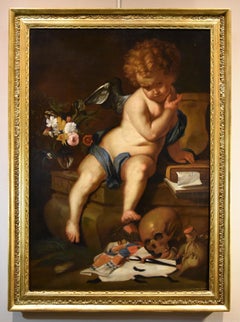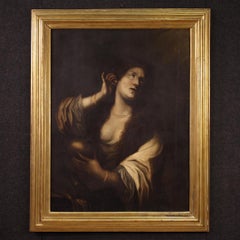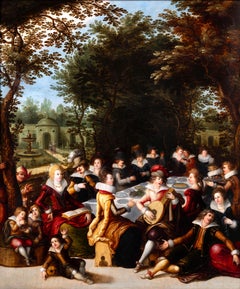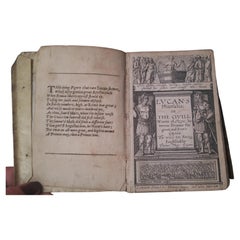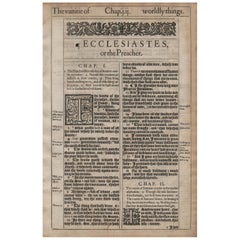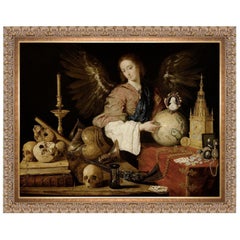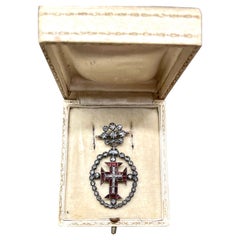Vanity 17th Century
to
5
2
7
7
1
1
1
1
1
Sort By
Quellinus Allegory Vanity Paint Oil on canvas old master 17th Century Flemish
Located in Riva del Garda, IT
Erasmus Quellinus II (Antwerp 1607 - 1672)
Vanitas (as an Allegory of the Vanity of Life or of
Category
17th Century Old Masters Paintings
Materials
Oil
17th Century Italian Oil on Canvas Painting Magdalene Renouncing the Vanities
Located in Vicoforte, IT
Italian painting from the second half of the 17th century. Oil painting on canvas from the
Category
1670s Figurative Paintings
Materials
Canvas, Oil
H 48.04 in W 38.59 in D 1.97 in
Feast in the Garden of Love, 17th century Antwerp, Louis de Caullery
Located in PARIS, FR
, before the vanities triumphed, in the 17th century, through the genre of still life.
Louis de Caullery
Category
Early 17th Century Old Masters Figurative Paintings
Materials
Oil, Wood Panel
Lucan's Pharsalia, Translated into English Verse by Thomas May, Esq;
Located in London, GB
Very good - Pages very clean and crisp. Binding tight/firm. Bumping & rubbing to spine 1665 M. ANNÆI LUCANI PHARSALIA, SIVE DE BELLO CIVILI CÆSARIS ET POMPEJI LIB [M. ANNAEUS Lucanus...
Category
Antique 17th Century European Vanity Items
"Vanity of Vanities", 1611 King James Bible, Ecclesiastes 1
By Robert Barker
Located in Albany, OR
Ecclesiastes 1-2. Title. "Vanity of Vanities" (1:1). First edition. Second issue. 1611 King James
Category
Antique 17th Century British Jacobean Prints
Materials
Cotton
Allegory of Vanity, After Baroque Oil Painting by Antonio de Pereda
Located in Fairhope, AL
This large, Fine Art masterpiece is a faithful yet nuanced reproduction of the "Allegory of Vanity
Category
Antique Mid-17th Century Spanish Baroque Decorative Art
Diamonds and Garnets Cross Templar Military Order of Christ Grand 1600s Brooch
Located in Viana do Castelo, PT
A Magnificent and very Rare, Museum Quality Seventeenth Century (1600s) Grand Cross of the
Category
Antique 17th Century Portuguese Medieval Vanity Items
Materials
Diamond, Garnet, Gold, Silver
Get Updated with New Arrivals
Save "Vanity 17th Century", and we’ll notify you when there are new listings in this category.
Vanity 17th Century For Sale on 1stDibs
Choose from an assortment of styles, material and more with respect to the vanity 17th century you’re looking for at 1stDibs. Each vanity 17th century for sale was constructed with extraordinary care, often using wood, paper and metal. There are many kinds of the vanity 17th century you’re looking for, from those produced as long ago as the 18th Century to those made as recently as the 21st Century. When you’re browsing for the right vanity 17th century, those designed in Art Deco, Victorian and Baroque styles are of considerable interest. A well-made vanity 17th century has long been a part of the offerings for many furniture designers and manufacturers, but those produced by Sinke & Van Tongeren, Louis Kuppenheim and Alfred Dunhill are consistently popular.
How Much is a Vanity 17th Century?
Prices for a vanity 17th century start at $150 and top out at $90,761 with the average selling for $3,700.
Questions About Vanity 17th Century
- 1stDibs ExpertSeptember 23, 2024What 17th-century furniture is called varies. The general term for all furniture produced 100 years ago, including 17th-century pieces, is antique furniture. You may also choose to be more specific and describe a piece by its style. Theatrical and lavish, the Baroque style was prevalent across Europe from the 17th to the mid-18th century and spread around the world through colonialism, including in Asia, Africa and the Americas. Baroque furniture was extravagant in all aspects, from shape to materials. 17th-century pieces from England often feature characteristics of the William and Mary style, such as crisp lines, maple and walnut veneers, inlaid bands and C-scroll ornaments. On 1stDibs, explore a variety of antique furniture.
- 1stDibs ExpertApril 5, 2022Sir Isaac Newton invented the reflector telescope in the 17th century. He created it as a replacement for the refracting telescope, which tended to have poor optics. Find a collection of antique and vintage telescopes on 1stDibs from some of the world’s top sellers.
- 1stDibs ExpertApril 5, 202217th-century Dutch portraiture has many similarities to other Baroque paintings, including rich colors, dark shadows and intense lighting. Many famous Dutch Baroque works lean toward realism. In Dutch portraiture, props and detailed backgrounds are uncommon. You'll find a collection of Dutch Baroque paintings from some of the world’s top art dealers on 1stDibs.
- 1stDibs ExpertMarch 22, 2022Yes, there were cannons in the 16th century. The history of the weapon dates back to 12th-century China. Historical records suggest that the first cannons appeared in Europe during the Islamic wars in Iberia in the 13th century. Find a range of antique cannons on 1stDibs.
- 1stDibs ExpertApril 5, 2022Yes, the history of glass-making goes back much further than the 1600s. It’s believed that they were making glass in different parts of the world at least 3,600 years ago, maybe even longer. During the late Bronze Age in Egypt and in Western Asia, glassmarking advanced significantly and was manipulated extensively to produce vessels, jewelry, and works of art. Shop a range of antique and vintage glass on 1stDibs.
- 1stDibs ExpertApril 5, 2022What painting is the most important of the 20th century is largely a matter of personal opinion. Some notable works produced during the period include Paul Cézanne's Mont Sainte-Victoire, Pablo Picasso's Les Demoiselles d'Avignon, Henri Matisse's The Dance and Jackson Pollock's Lavender Mist. Shop a large selection of 20th-century paintings on 1stDibs.
- 1stDibs ExpertApril 5, 2022A variety of furniture was used during the 16th century. Items commonly found in homes include high-backed armchairs, chests, stools, benches and cupboards. Most European artisans active during the time period produced pieces out of oak wood. Find a large collection of antique furniture on 1stDibs.
- 1stDibs ExpertApril 5, 2022Yes, wedding rings have a long history, stretching back to ancient Egypt. The first diamond engagement ring was created in 1477 by Archduke Maximillian of Austria. Browse a wide array of vintage and contemporary wedding rings on 1stDibs.
- 1stDibs ExpertApril 5, 2022In the 18th century, art changed in style from Baroque to Rococo and Neoclassicism. Art became more ornamented and idealized during the Rococo period and then shifted toward a style that emulated the artwork of ancient Greece and Rome near the end of the century. You’ll find a variety of fine art on 1stDibs.
- 1stDibs ExpertNovember 13, 2024To identify 18th-century furniture, you can research your piece in the context of the prevailing styles of the period or consult a certified appraiser or experienced antique dealer. To identify your item on your own, look over it for maker's marks, such as carvings, stamps, brands and labels. Researching the marking can help you determine the maker of your piece, and from there, you can search further to learn more about your particular item. Without a maker's mark, the best approach is to consider the characteristics of the dominant furniture styles during the 18th century. In England, these included William and Mary, Queen Anne, Georgian, Chippendale, Hepplewhite and Sheraton. Some French furniture styles of the 1700s include Louis XV, Louis XVI and Régence. Find a diverse assortment of 18th-century furniture on 1stDibs.
- 1stDibs ExpertApril 5, 2022One way to check if your brass candlesticks are from the 18th century is to look for the two seams running lengthwise on either side. This is from when the candlestick was molded in two halves and then soldered together. You’ll find a variety of candlesticks of all shapes and sizes from some of the top sellers on 1stDibs.
- 1stDibs ExpertApril 5, 2022British artist John Singer Sargent was one of the most important portrait painters of the 19th century. Other notable portraitists from the period include James Abbott McNeill Whistler, Eugène Delacroix, Théodore Géricault, Gustave Courbet, Édouard Manet, Mary Cassat, Claude Monet and Pierre-Auguste Renoir. On 1stDibs, find a wide variety of portrait paintings.
- 1stDibs ExpertJanuary 10, 2025The individuals considered the Big Three of 18th-century cartoons are William Hogarth, James Gillray and George Cruikshank. Although the 18th century saw a widespread increase in illustrations in newspapers, these three illustrators were particularly well-known for their work. Hogarth's work was extremely diverse, ranging from serious, realistic paintings and portraits to satirical and moralistic illustrations filled with symbolism. A British caricaturist, Gillray is remembered today for his artworks representing political and social satires, like his political cartoons against George III of England. Despite being a prolific caricaturist, Cruikshank is now most famous for illustrating the works of Charles Dickens. On 1stDibs, find a wide variety of illustrations.
- 1stDibs ExpertApril 5, 2022The French painters of the 19th century worked in two styles. Neoclassicism dominated the first half of the century, and Impressionism was the most common style during the second half. On 1stDibs, you can find a variety of French paintings.
- 1stDibs ExpertApril 5, 2022At the end of the 17th century, Europe went into a frenzy over porcelain. Asian porcelain was highly sought after, and spurred the foundation of the Meissen factory in France, where hard porcelain went on to be made. You’ll find a large collection of porcelain pieces from many of the world’s top sellers on 1stDibs.
